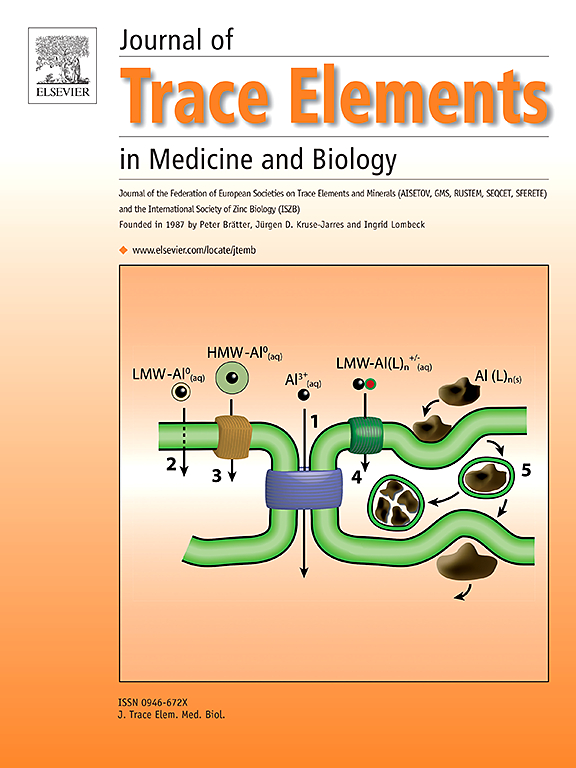器官铁水平与2型糖尿病和血糖特征的关系:一项双向双样本孟德尔随机研究。
IF 3.6
3区 医学
Q2 BIOCHEMISTRY & MOLECULAR BIOLOGY
Journal of Trace Elements in Medicine and Biology
Pub Date : 2025-02-01
DOI:10.1016/j.jtemb.2024.127586
引用次数: 0
摘要
观察性研究发现,高铁水平与糖尿病风险增加有关。鉴于观察性研究的因果推断的局限性以及随机对照试验的昂贵和耗时的性质,孟德尔随机化分析提供了一个合理的替代研究因果关系。先前研究铁水平和糖尿病的核磁共振分析使用了间接的铁水平标记物,如血清铁蛋白,并发现了相互矛盾的结果。在这项研究中,我们使用器官铁(肝、脾和胰腺)水平进行双向孟德尔随机分析,研究铁水平与2型糖尿病和血糖特征的因果关系,这些器官铁水平是铁状态的更直接标志。方法:使用来自全基因组关联研究(UK-Biobank、DIAGRAM和MAGIC联盟)的汇总数据,采用两种样本磁共振分析双向研究肝、脾和胰腺铁水平对2型糖尿病和血糖特征的因果关系,以及2型糖尿病对器官铁水平的因果关系。与器官铁水平相关的snp(截断值P -7)被用作MR分析器官铁水平对2型糖尿病/血糖性状影响的工具变量,与糖尿病相关的snp(截断值P -8)被用作MR分析2型糖尿病对器官铁水平因果影响的工具变量。血清铁蛋白(deCODE、UK INTERVAL和丹麦研究的GWAS荟萃分析)和血红蛋白(血细胞联盟)被用作阳性对照,以肝铁作为暴露。初步分析采用方差逆加权瓦尔德比均值。敏感性分析包括反方差加权中位数、加权模式和MR-Egger方法。结果:我们的研究结果显示肝脏和胰腺铁水平与2型糖尿病之间没有因果关系(肝铁:OR = 1.02, P = 0.1,胰腺铁:OR = 1.11, P = 0.5)。除了肝铁水平对HbA1c的负因果影响(OR = 0.93, P = 0.001)外,这也适用于血糖特征。脾铁水平与2型糖尿病呈负相关(OR = 0.94, P = 0.049)。然而,这些例外可能是由于可能的多效性,因为这些关联可以通过基因变异对错误降低HbA1c水平的因素的影响来解释。没有发现2型糖尿病对器官铁水平影响的因果关系。结论:器官铁水平是相对更直接的铁状态指标,在欧洲人群中与2型糖尿病没有因果关系。本文章由计算机程序翻译,如有差异,请以英文原文为准。
Association of organ iron levels with type 2 diabetes mellitus and glycemic traits: A bidirectional two-sample Mendelian randomization study
Introduction
Observational studies have found that higher iron levels are associated with an increased risk of diabetes mellitus. Given the limitations of causal inferences from observational studies and the expensive and time-consuming nature of randomized controlled trials, Mendelian randomization analysis presents a reasonable alternative to study causal relationships. Previous MR analyses studying iron levels and diabetes have used indirect markers of iron levels, such as serum ferritin, and found conflicting results. In this study, we performed bidirectional Mendelian Randomization analyses using organ iron (liver, spleen, and pancreas) levels, which are more direct markers of iron status, to study the causal association of iron levels with type 2 diabetes mellitus and glycaemic traits.
Methods
Two sample MR analyses were employed bi-directionally to study the causal effect of liver, spleen, and pancreas iron levels on type 2 diabetes and glycaemic traits and the causal effect of type 2 diabetes on organ iron levels, using summary data from genome-wide association studies (UK-Biobank, DIAGRAM, and MAGIC consortia). SNPs associated with organ iron levels with a cut-off of P < 5 × 10−7 were used as instrumental variables for the MR analyses of the effect of organ iron levels on type 2 diabetes/glycaemic traits, and SNPs associated with diabetes mellitus with a cut-off of P < 5 × 10−8 were used as instrumental variables for the MR analyses of the causal effect of type 2 diabetes on organ iron levels. Serum ferritin (GWAS meta-analysis of deCODE, UK INTERVAL, and Denmark studies) and haemoglobin (Blood Cell consortium) were used as positive controls for the MR analysis with liver iron as the exposure. Primary analyses used the inverse variance weighted means of Wald’s ratio. Sensitivity analyses included inverse variance weighted median, weighted mode, and MR-Egger methods.
Results
Our findings reveal no causal association between liver and pancreas iron levels with type 2 diabetes (Liver iron: OR = 1.02, P = 0.1, Pancreas iron: OR = 1.11, P = 0.5). This also holds for glycaemic traits, except for the negative causal effect of liver iron levels on HbA1c (OR = 0.93, P = 0.001). Spleen iron levels had a negative causal effect on type 2 diabetes (OR = 0.94, P = 0.049). However, these exceptions are likely due to possible pleiotropy, as these associations can be explained by the effect of the genetic variants on factors that falsely decrease HbA1c levels. No causal association was found for the effect of type 2 diabetes on organ iron levels.
Conclusion
Organ iron levels, which are relatively more direct indicators of iron status, showed no causal association with type 2 diabetes in the European population.
求助全文
通过发布文献求助,成功后即可免费获取论文全文。
去求助
来源期刊
CiteScore
6.60
自引率
2.90%
发文量
202
审稿时长
85 days
期刊介绍:
The journal provides the reader with a thorough description of theoretical and applied aspects of trace elements in medicine and biology and is devoted to the advancement of scientific knowledge about trace elements and trace element species. Trace elements play essential roles in the maintenance of physiological processes. During the last decades there has been a great deal of scientific investigation about the function and binding of trace elements. The Journal of Trace Elements in Medicine and Biology focuses on the description and dissemination of scientific results concerning the role of trace elements with respect to their mode of action in health and disease and nutritional importance. Progress in the knowledge of the biological role of trace elements depends, however, on advances in trace elements chemistry. Thus the Journal of Trace Elements in Medicine and Biology will include only those papers that base their results on proven analytical methods.
Also, we only publish those articles in which the quality assurance regarding the execution of experiments and achievement of results is guaranteed.

 求助内容:
求助内容: 应助结果提醒方式:
应助结果提醒方式:


